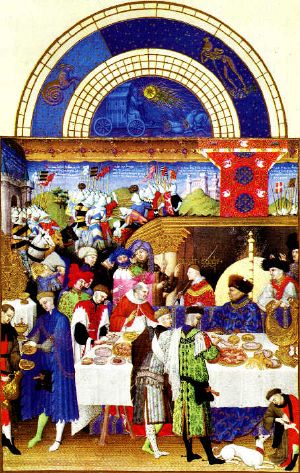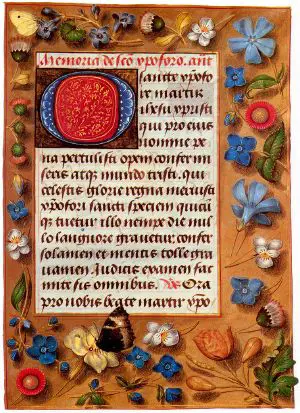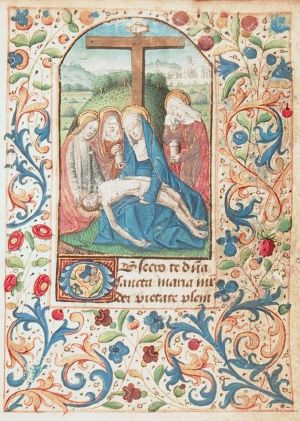Book of Hours
The Books of Hours (Latin: Horae; English: Primer)[1] represented a class of devotional manuals popular among medieval Catholic laity. Their ubiquity among fourteenth, fifteenth and sixteenth century Christians has led to is a type of category of the most common type of surviving medieval illuminated manuscript. Each book of hours is unique in one way or another, but all contain a collection of texts, prayers and psalms, along with appropriate illustrations, to form a reference for Catholic Christian worship and devotion.
The Latin name for a book of hours is . The original books were always written in Latin. There are over 800 books of hours made in England scattered to libraries all over the world.
Content
In its original form, a book of hours would list the appropriate texts for each liturgical hour of the day. However, over time, other references were often added, especially calendars of the religious and secular year along with the prayers and masses required for certain holy days. Owners often added their own notes.
The typical medieval manuscript called a book of hours is an abbreviated breviary, the book containing the liturgy recited in cloistered monasteries. The books of hours were composed for the lay people who wished to incorporate elements of monasticism into their devotional life. Reciting the hours typically centered upon the recitation or singing of a number of psalms, accompanied by set prayers. A typical book of hours contained:
- The Little Office of the Blessed Virgin Mary, which included the fifteen Psalms of Degrees;
- The Office for the Dead, which included the seven Penitential Psalms;
- The Litany of Saints
Most books of hours began with these basic contents, and expanded them with a variety of prayers and devotions. The Marian prayers Obsecro te ("I beseech thee") and O Intemerata ("O undefiled one") were frequently added, as were devotions for use at Mass, and meditations on the Passion of Christ.
History
Originally the prayers in a book of hours were private ones but by the 12th century had become routine liturgical ones in the monasteries. After the Fourth Lateran Council, laypeople also become interested in them. Many of them were made for women. After the 1340s and the Black Death, the lay interest of these prayer books increased further.
Originally only the royalty, nobility, and the rich could afford to have their personal book of hours. Sometimes the books included prayers specifically composed for their owners or adapted to their tastes or gender, including adding their personal names to suitable prayers. Some of the surviving ones include portraits of their owners.
By the 15th century, various stationer's shops mass-produced books of hours in the Netherlands and France. By the end of the 15th century, the advance of printing made the books more affordable and sometimes even commoners and servants could afford to buy one of the printed, unbound books of hours for their own use, leading them to become more popular than Psalters.
Decorations
As many books of hours are richly illuminated, they form an important record of life in the 15th and 16th centuries as well as the iconography of medieval Christianity. Some of them were also decorated with jewelled covers, portraits, heraldic emblems, numerous illustrations, textual illuminations and marginal decorations. Many were bound as girdle books for easy carrying. Many, like the Talbot Hours of John Talbot, 1st Earl of Shrewsbury, include a portrait of the owner, and in this case his wife, kneeling in adoration of the Virgin and Child. Large miniature cycles often covered the Labours of the Months, decorating the calendar, the Life of the Virgin in eight scenes decorating the Hours of the Virgin, which were sometimes decorated with the Passion of Christ instead.
The amount of money the books of hours represented made them also important status symbols that the wealthy wanted to have whether they were pious or not. Wealthy people also sometimes competed trying to outdo each other with decorations of the books they commissioned. The books were also often passed along as gifts to favoured children, friends and servants and even as signs of dynastic allegiances. A mother could pass her book on to her eldest daughter, and the same book could pass along in the same family for centuries. Various queens gave books to their favoured ladies in waiting.
Long-lived books of hours could also be modified for their new owner. After defeating Richard III, Henry VII gave Richard's book of hours to his mother, and she modified it to include her name. Many surviving books have numerous handwritten annotations, personal additions and marginal notes but some new owners also commissioned new craftsmen to include more illustrations or scripts. Sir Thomas Lewkenor of Trotton hired an illustrator to add details to what is now known as the Lewkenor Hours.
The pages of books with a less glorious fate could have been just used for notes and scrap paper. Flyleaves of many surviving books include notes of household accounting or records of births and deaths. Some owners had also collected autographs and remembrances of visitors.
Towards the end of the 15th century, printers produced books of hours with woodcut illustrations. Stationers could mass-produce manuscript books on vellum with only plain artwork and later "personalize" them with equally mass-produced sets of illustrations from local printers.
Sample books of hours
One of the most famous books of hours, and one of the most richly illuminated medieval manuscripts, is the Très Riches Heures painted sometime between 1412 and 1416 in France for John, Duke of Berry.
The De Brailes Hours was made around 1240. It is the earliest surviving English book of hours and includes four portraits of its first owner.
The Rothschild Prayerbook
The Rothschild Prayerbook, use of Rome, was made c. 1505 and is only three and a half inches thick. Louis Nathaniel von Rothschild owned it but Nazis confiscated the medieval Rothschild Book of Hours immediately after the March 1938 German annexation of Austria from members of the Viennese branch of the Mayer Amschel Rothschild family. Through the efforts of Bettina Looram-Rothschild, the niece and heir of the owner, the government of Austria returned the book and other works of art to her in 1999. It was sold for Ms Looram-Rothschild by Christie's auction house of London on July 8, 1999 for £8,580,000 ($13,400,000), a world auction record price for an illuminated manuscript.
The Connolly Book of Hours
The Connolly Book of Hours, was produced during the fifteenth century and is an excellent example of a manuscript Book of Hours produced for a non-aristocratic patron. It was the subject of a 1999 volume by Timothy M. Sullivan, et al, that documented and contextualized all the illuminated leaves in the book.
See also
- Canonical hours
- Horologion
Notes
- ↑ This usage is attested to in the Oxford English Dictionary, which states: "The medieval Primarium or Primer was mainly a copy, or (in English) a translation of different parts of the Breviary and Manual. In the 14th and 15th centuries, in its simplest form, it contained the Hours of the Blessed Virgin (the essential element), the 7 Penitential and 15 Gradual Psalms, the Litany, the Office for the Dead (Placebo and Dirige), and the Commendations; to which however various additions were often made. Early 16th cent. printed editions of these medieval works were freq. given the name Prymer on the title page. ... After 1600 the word gradually lost these religious meanings, although in 17th-cent. England it continued to be used to denote a Roman Catholic prayer book translated into the vernacular" (2007). See also: the entry in the Online Etymology Dictionary.
ReferencesISBN links support NWE through referral fees
- Chilvers, Ian (ed). The Oxford Dictionary of Art. Oxford: Oxford University Press, 2004. ISBN 0198604769.
- Duffy, Eamon. The Stripping of the Altars: Traditional Religion in England 1400-1580. New Haven, CT: Yale, 1992. Second Printing, 2005. ISBN 0-300-06076-9
- Duffy, Eamon. "A Very Personal Possession." History Today 56:11 (November 2006). 12-18.
- Thurston, Herbert. "Prayer Books." Catholic Encyclopedia. New York: Robert Appleton Company, 1911.
- Thurston, Herbert. "The Primer." Catholic Encyclopedia. New York: Robert Appleton Company, 1911.
- Toke, Leslie A. St. L. "Little Office of Our Lady." Catholic Encyclopedia. New York: Robert Appleton Company, 1910.
External links
All links retrieved October 17, 2007
- A Hypertext Book of Hours; full texts and translation
- A catalog of images from various illuminated manuscripts
- Late Medieval and Renaissance Illuminated Manuscripts - Books of Hours 1400-1530 - An excellent guide to the Book of Hours as a literary and devotional artifact. Featuring original Latin texts and high-resolution photographs of many books.
- Online Versions of Individual Manuscripts
- Book of Hours (Ms. Library of Congress. Rosenwald ms. 10) From the Rare Book and Special Collections Division of the Library of Congress.The same in pdf format.
- MS Richardson 7. Heures de Nôtre Dame at Houghton Library, Harvard University.
- A Masterpiece Reconstructed: The Hours of Louis XII. Victoria and Albert Museum. Retrieved 2007-08-27.
Credits
New World Encyclopedia writers and editors rewrote and completed the Wikipedia article in accordance with New World Encyclopedia standards. This article abides by terms of the Creative Commons CC-by-sa 3.0 License (CC-by-sa), which may be used and disseminated with proper attribution. Credit is due under the terms of this license that can reference both the New World Encyclopedia contributors and the selfless volunteer contributors of the Wikimedia Foundation. To cite this article click here for a list of acceptable citing formats.The history of earlier contributions by wikipedians is accessible to researchers here:
The history of this article since it was imported to New World Encyclopedia:
Note: Some restrictions may apply to use of individual images which are separately licensed.


